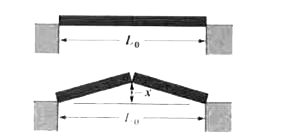
As a result of temp rise of 32∘C, a bar with a crack at its centre buckless upward. If the fixed distance l0 is 4m, and coefficeient of linear expansion of bar in 25×10−5'∘C−1. Find the rise x (in cm) of the centre.
The correct Answer is:8
Step by step video, text & image solution for As a result of temp rise of 32^(@)C, a bar with a crack at its centre buckless upward. If the fixed distance l_(0) is 4m, and coefficeient of linear expansion of bar in 25 xx 10^(-5)'^(@)C^(-1). Find the rise x (in cm) of the centre. by Physics experts to help you in doubts & scoring excellent marks in Class 11 exams.
Updated on:21/07/2023Topper's Solved these Questions
- CALORIMETRY AND THERMAL EXPANSIONBOOK - RESONANCECHAPTER - CALORIMETRY AND THERMAL EXPANSIONEXERCISE - Exercise-2
1 Video
- CALORIMETRY AND THERMAL EXPANSIONBOOK - RESONANCECHAPTER - CALORIMETRY AND THERMAL EXPANSIONEXERCISE - Exercie-3
1 Video
- CALORIMETRY AND THERMAL EXPANSIONBOOK - RESONANCECHAPTER - CALORIMETRY AND THERMAL EXPANSIONEXERCISE - Exercise-1
1 Video
- CALORIMETRYBOOK - RESONANCECHAPTER - CALORIMETRYEXERCISE - Exercise
19 Videos
- CAPACITORBOOK - RESONANCECHAPTER - CAPACITOREXERCISE - Exercise
45 Videos
Similar Questions
As a result of temperature rise of 32∘C a bar with a crack at its centre buckles upwards. If the fixed distance be L0=4.0m and the temperature coefficient of linear expansion be α=25×10−6/C∘, find the distance x by which the centre rises.
View SolutionAs a result of a temperature rise of 64∘C , a bar with a crack at centre buckles upward (Fig . 18-20 ). The fixed distance L0 is 3.77 m and the coefficient of linear expansion of the bar is Find the rise 25×10−6/∘C of the centre .

View Solution
Knowledge Check
An iron bar 10 cm in length is kept at 20∘C. If the coefficient of linear expansion of iron is α=11×10−6.∘C−1, then at 19∘C it will be
A11×10−6cm longerB11×10−6cm shorterC11×10−5cm shorterD11×10−5cm longerA uniform metal rod is used as a bar pendulum. If the room temperature rises by 10∘C, and the coefficient of linear expansion of the metal of the rod is 2×10−6per∘C, the period of the pendulum will have percentage increase of
A−2×10−3B−1×10−3C2×10−3D1×10−3
A bar with a crack at its centre buckles as a result of temperature rise of 32∘C. If the fixed distacne L0 is 3.77 m and the coefficient of linear expansion of the bar is 25×106/∘C find the rise (in metre) of the centre.
View SolutionCoefficient of areal expansion of a solid is 2×10−5.∘C−1. Calculate its coefficient of linear expansion.
View SolutionA copper bar is 80 cm long at 15∘C. What is the increase in length, when heated to 35∘C? The coefficient of linear expansion for copper is 1.7×10−5.∘C−1
View SolutionAn iron bar of length 10 m is heated from 0∘C to 100∘C. If the coefficient of linear thermal expansion of iron is 10×10−6.∘C−1 , then increase in the length of bar (in cm ) is
View SolutionA aluminium can of cylindrical shape contains 500cm3 of water. The area of the inner cross section of the can is 125cm2. All measurements refer to 10∘C. Find the rise in the water level if the temperature increases to80∘C. The coefficient of linear expansion of aluminium =23×10−6∘C−1 and the average coefficient of volume expansion of water = 3.2×10−4∘C−1 respectively
View SolutionA string in a guitar is made of steel (density 7962kg/m3). It is 63.5 cm long, and has diameter of 0.4 mm. The fundamental frequency is f=247Hz.
(a) Find the string tension (F).
(b) If the tension F is changed by a small amount ΔF, the frequency f changes by a small amount Δf. Show that Δff=12ΔFF
(c) The string is tuned with tension equal to that calculated in part (a) when its temperature is 18∘C. Continuous playing causes the temperature of the string to rise, changing its vibration frequency. Find Δf if the temperature of the string rises to 29∘C. The steel string has a Young’s modulus of 2.00×1011Pa and a coefficient of linear expansion of 1.20×10–5(.∘C)–1. Assume that the temperature of the body of the guitar remains constant. Will the vibration frequency rise or fall?
View Solution
